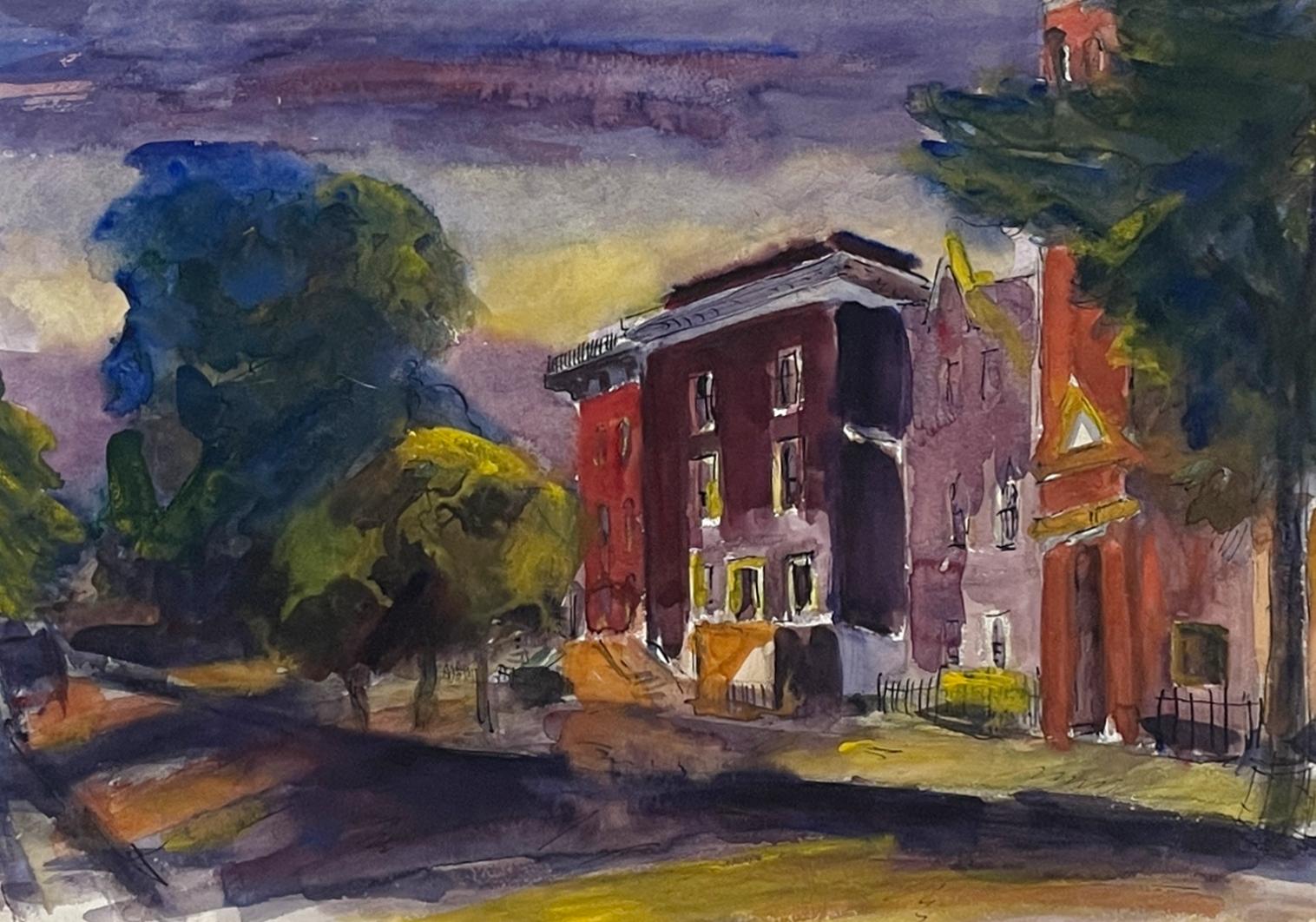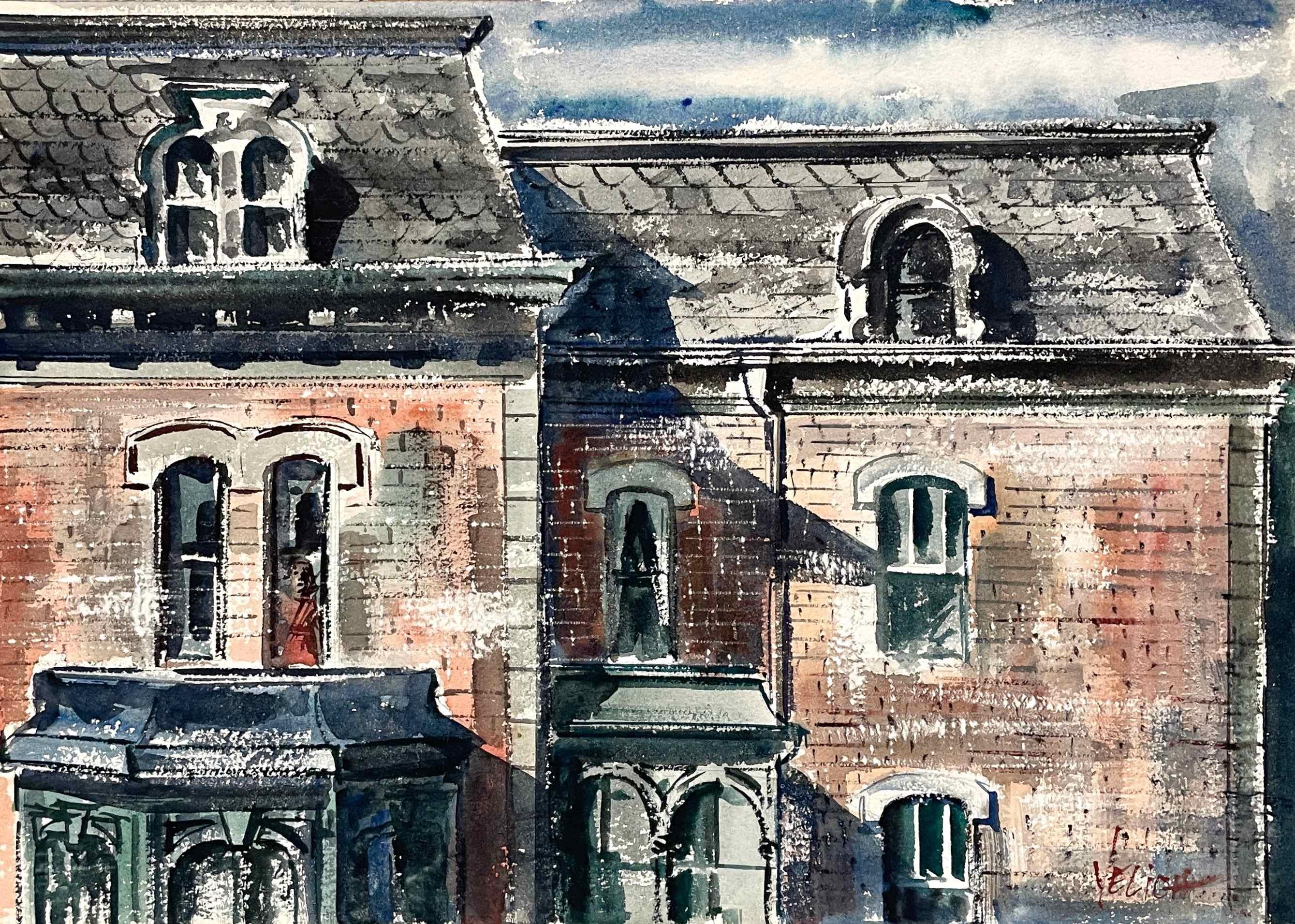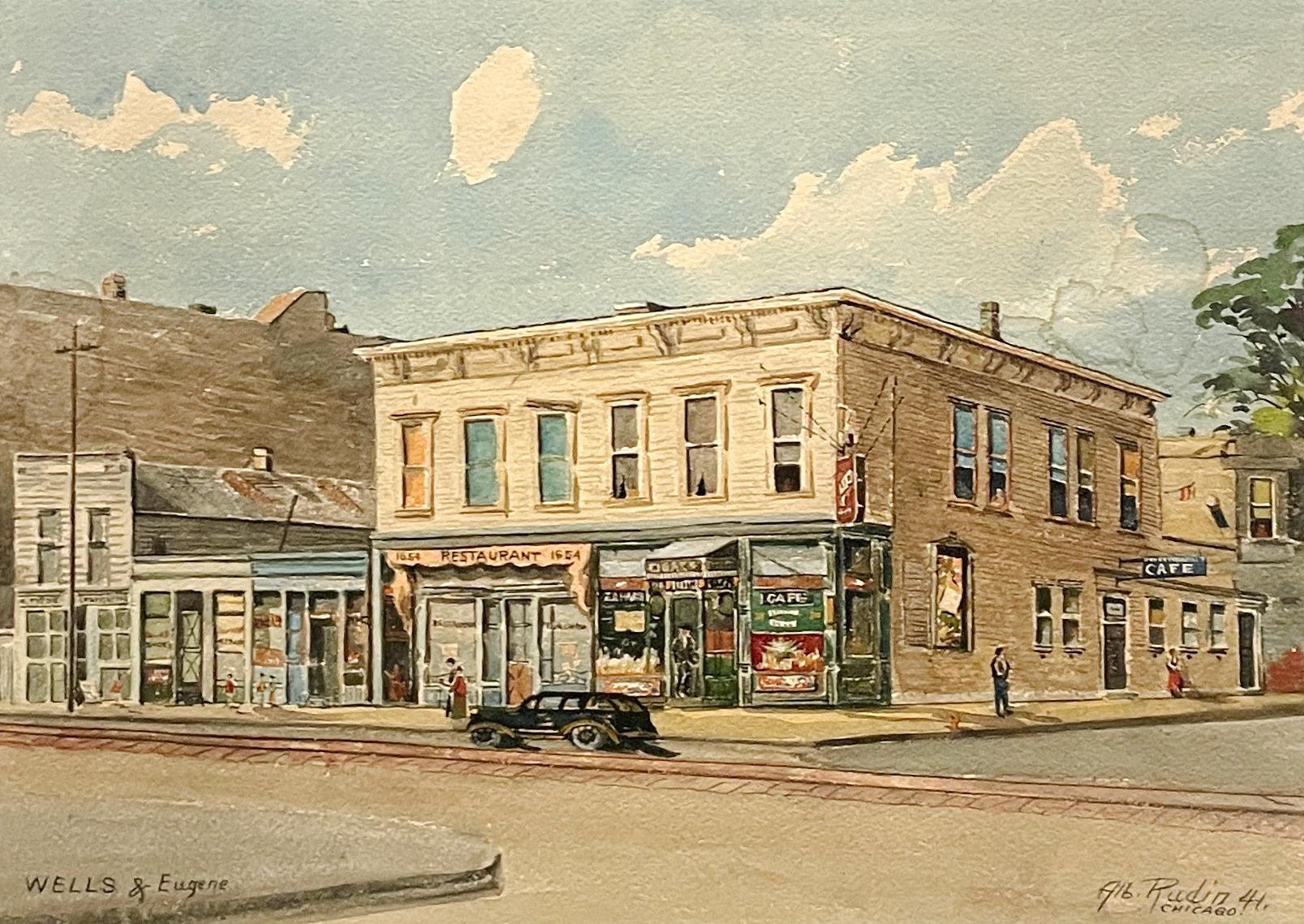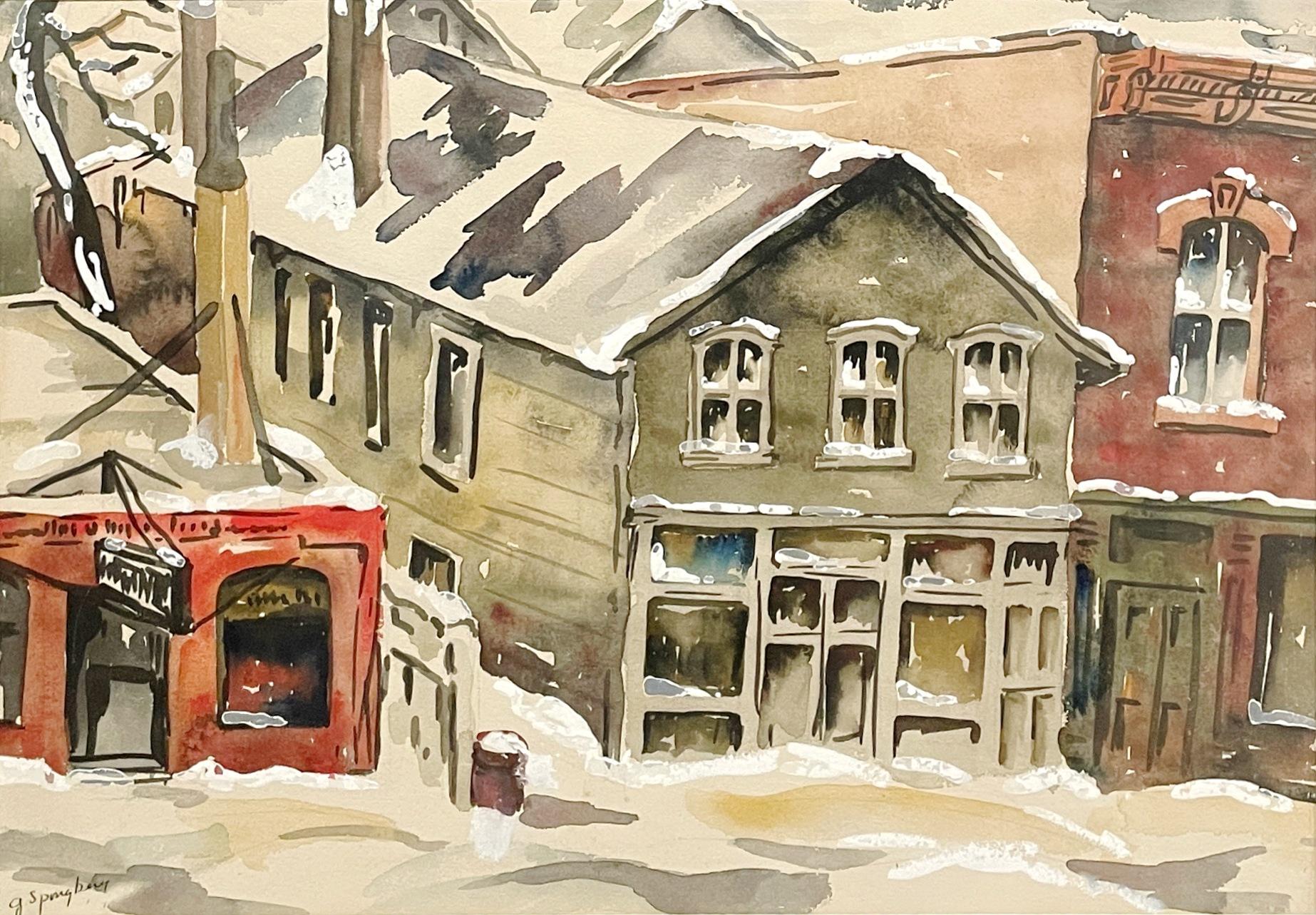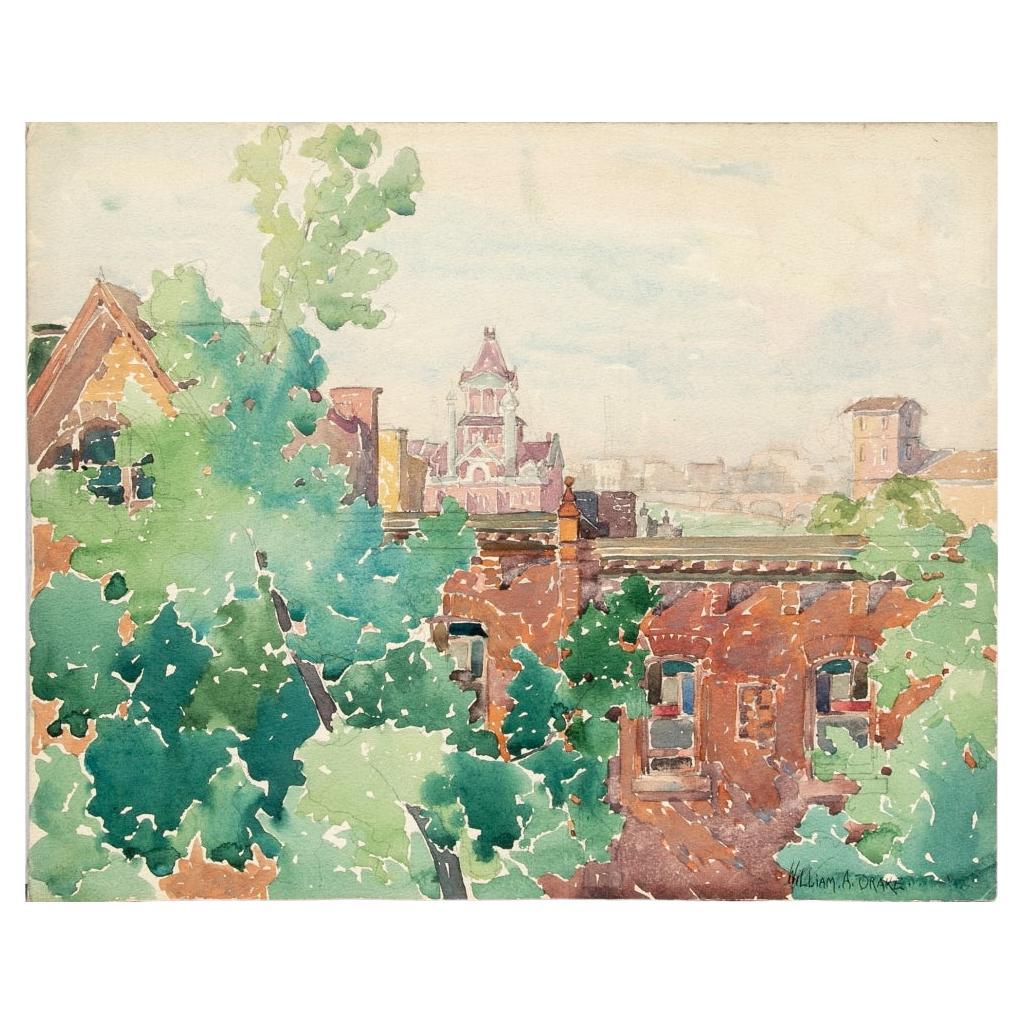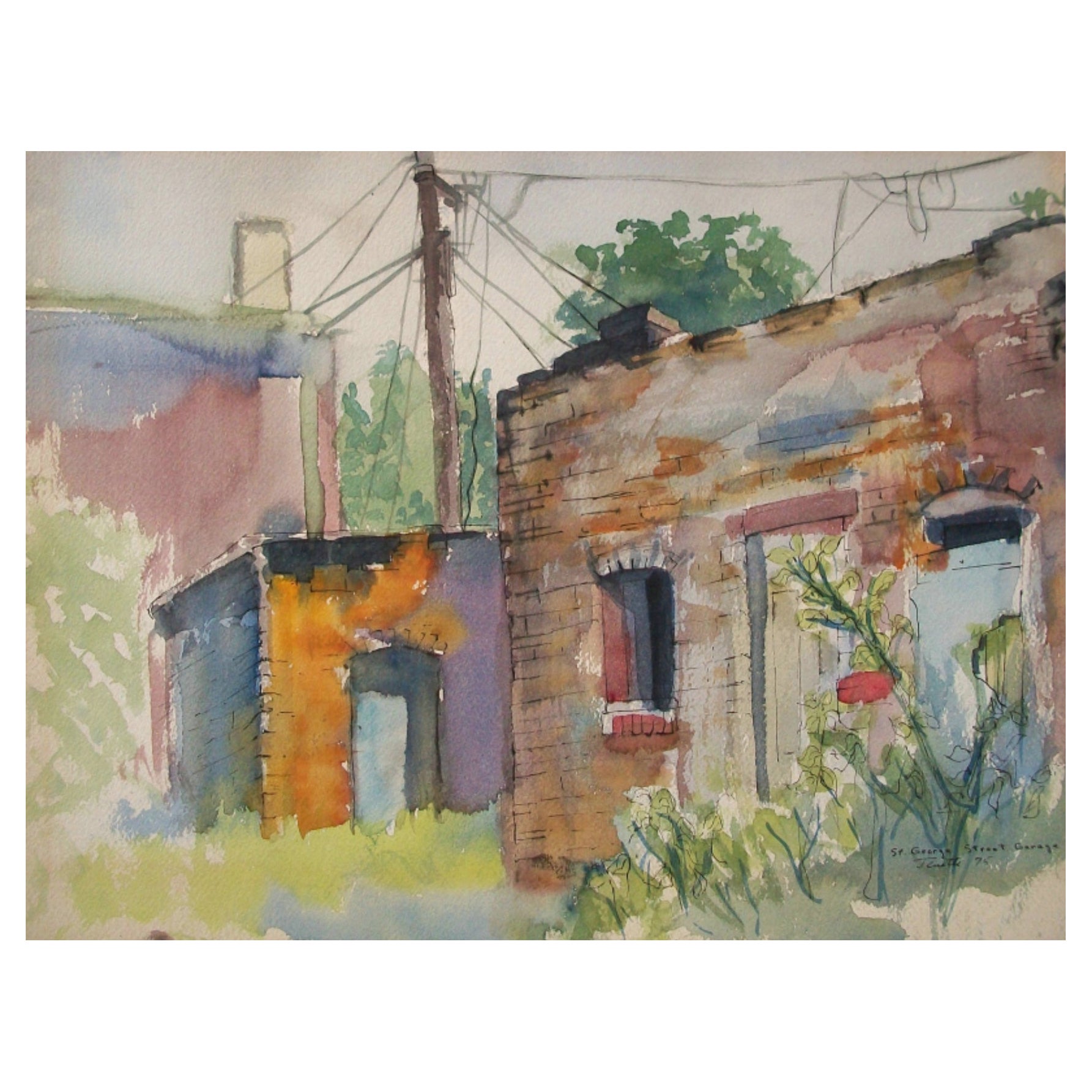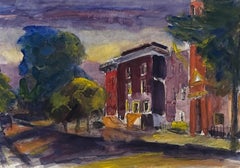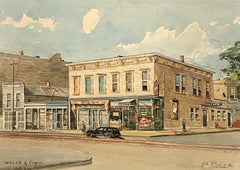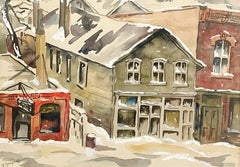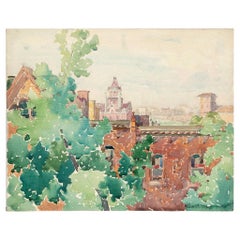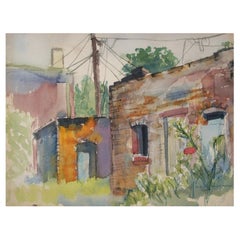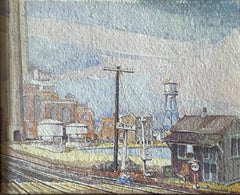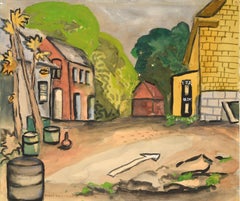Items Similar to 1930s Watercolor of a Chicago Rail Yard by Notable Chicago Artist Tunis Ponsen
Want more images or videos?
Request additional images or videos from the seller
1 of 9
Tunis Ponsen1930s Watercolor of a Chicago Rail Yard by Notable Chicago Artist Tunis Ponsenca. 1930s
ca. 1930s
$950
£726.33
€836.58
CA$1,331.24
A$1,486.21
CHF 778.75
MX$18,192.62
NOK 9,890.13
SEK 9,325.13
DKK 6,243.49
Shipping
Retrieving quote...The 1stDibs Promise:
Authenticity Guarantee,
Money-Back Guarantee,
24-Hour Cancellation
About the Item
A 1930s Watercolor titled "Chicago Rail Yard" by important Chicago/Michigan artist Tunis Ponsen. Image size: 10 1/2" x 15 1/2". Framed size: 18" x 23 1/2". This watercolor comes from the notable Friedlander Collection of Chicago.
Tunis Ponsen (1891-1968) Fishing Boats Riding at Anchor
The paintings of Tunis Ponsen are among the most underestimated works in the both academia and the art market. For 37 years Tunis Ponsen painted oils, watercolors, and drawings detailing his impressions and understanding of American life. Critically acclaimed during his lifetime, Ponsen was widely exhibited in Chicago and achieved a modicum of praise and financial success.
Beginning his sojourn as an artist relatively late at age 30, Ponsen had been in the United States only a brief period when he began to paint. He emigrated from his native Holland in 1913 and settled in Muskegon, Michigan where he began his new life as a professional house painter. It was during his 30th year, that a local patron of the arts helped Ponsen to have his first solo exhibition at the Hackley Gallery in Muskegon. Ponsen's success as a traditional painter strengthened in 1924 when he relocated to Chicago in order to attend the Art Institute. There he studied with Karl Buehr, George Oberteuffer, and Leon Kroll.
Ponsen continuously exhibited his work over the years, between 1924 and 1938; his work was included in 34 museum exhibitions. His work found a supportive audience in the Detroit Institute of Art, Toledo Museum of Art, the Art Institute of Chicago, the Flint Institute of Arts, Muskegon Museum of Art, and the Pennsylvania Academy of Fine Arts, among others. Throughout his career, critics favored him with positive commentary, such as Irwin St. John, critic for the Chicago Herald & Examiner, who stated
"[Mr. Ponsen] brings to his art the serious solidity of a Dutch Conception. He builds his foundations deep and true, and on them erects his painting - even though it be of a subject as transitory as a clouds or a sail flapping in the wind - with careful methodical structure, until the passing moment he has seized upon stand fixed for all time. This man takes what we used to call modernism, gets the good out of it, and makes it glorious."
In 1926, Ponsen, like many of his contemporaries, flocked to the colony in Gloucester, Mass. to capture the timeless wharves, boats, fisherman, and townships. There he studied from American Impressionist masters such as Charles Hawthorne and Richard Miller the art of plein-air. Ponsen was inspired by the harbor scenes he found there. "Wharfing and shipping seem to have a special fascination for the artist whose fishing boats riding at anchor look easily capable of sailing away to the fishing grounds and the day's haul."
One observer from a 1938 exhibition noted that "Ponsen's paintings' grow on you. At first they may strike you as a trifle harsh, perhaps a bit too blunt. But go back to the creations again and you will appreciate that while Ponsen's method is conscientiously abrupt, it is far from crude. You begin to feel the downright integrity of the artist. These paintings are not color poems, mood symphonies or anything of the sort. This is prose, straightforward and deliberate... shorn of all superlatives, done by a man well trained in the grammar of art."
Ponsen painted until his death in 1968. He settled in Chicago as a landscape painter and was a member of the Chicago Painters and Sculptors, Chicago Gallery Association, and the Chicago Society of Artists. While Ponsen's works are mostly associated with the impressionistic school, his careful use of bold color and sweeping brushstrokes are often reminiscent of another prestigious Dutch artist, Vincent Van Gogh. Tunis Ponsen is best known for his use of urban scenes, country landscapes, and harbor scenes.
A critic once said "He is never guilty of adding sugar and spice that might make a rich and popular pastry for rapid and eager consumption. Rather, his work is as substantial and wholesome as bread - and no more difficult to digest."
Source: "The Lost Paintings of Tunis Ponsen", Muskegon Museum of Art, 1994.
- Creator:Tunis Ponsen (1891 - 1968, American, Dutch)
- Creation Year:ca. 1930s
- Dimensions:Height: 18 in (45.72 cm)Width: 23.5 in (59.69 cm)
- More Editions & Sizes:Framed size: 18" x 23 1/2"Price: $950
- Medium:
- Movement & Style:
- Period:
- Condition:See Photos.
- Gallery Location:Chicago, IL
- Reference Number:Seller: #81601stDibs: LU2591215785442
About the Seller
5.0
Recognized Seller
These prestigious sellers are industry leaders and represent the highest echelon for item quality and design.
Established in 2000
1stDibs seller since 2023
71 sales on 1stDibs
Typical response time: 3 hours
- ShippingRetrieving quote...Shipping from: Chicago, IL
- Return Policy
Authenticity Guarantee
In the unlikely event there’s an issue with an item’s authenticity, contact us within 1 year for a full refund. DetailsMoney-Back Guarantee
If your item is not as described, is damaged in transit, or does not arrive, contact us within 7 days for a full refund. Details24-Hour Cancellation
You have a 24-hour grace period in which to reconsider your purchase, with no questions asked.Vetted Professional Sellers
Our world-class sellers must adhere to strict standards for service and quality, maintaining the integrity of our listings.Price-Match Guarantee
If you find that a seller listed the same item for a lower price elsewhere, we’ll match it.Trusted Global Delivery
Our best-in-class carrier network provides specialized shipping options worldwide, including custom delivery.More From This Seller
View All1930s Cheerful Watercolor of a Chicago Street Scene by Constantine Pougialis
Located in Chicago, IL
A 1930s cheerful & colorful watercolor depicting a Chicago Street scene by artist Constantine Pougialis. Image size: 15" x 22". Painting bears its original frame, which measures 21...
Category
1930s American Modern Landscape Drawings and Watercolors
Materials
Paper, Watercolor
Captivating Mid-Century Watercolor of an Old Chicago House by George Yelich
Located in Chicago, IL
A captivating Mid-Century watercolor of an old Chicago house (with a female figure standing in the window) by Chicago artist George Yelich. The watercolor bears its original frame. ...
Category
1950s American Modern Landscape Drawings and Watercolors
Materials
Paper, Ink, Watercolor
1941 Watercolor of Chicago's Old Town, Titled "Wells & Eugenie" by Albert Rudin
Located in Chicago, IL
A wonderful 1941 watercolor of Chicago's Old Town neighborhood that features an old car, titled "Wells & Eugenie" by Albert Rudin. Image size: 11 1/2" x 15 1/2". Framed size: 18"...
Category
1940s American Modern Landscape Drawings and Watercolors
Materials
Paper, Watercolor
A 1940s American Scene Watercolor of a Chicago Street Scene by Grace Spongberg
Located in Chicago, IL
A 1940s American Scene watercolor depicting a snowy Chicago Street Scene by artist Grace Spongberg. Image size: 12 1/2" x 17". Framed size: 18 1/2" x 22 1/2". This painting come...
Category
1940s American Modern Landscape Drawings and Watercolors
Materials
Paper, Watercolor
Ca. 1950s Watercolor Titled Canadian National RR at Antigonish by Rita Duis
Located in Chicago, IL
A curious ca. 1950s watercolor of railroad freight car, titled "Canadian National RR at Antigonish" by artist Rita Duis. Image size: 14 3/4" x 22". Matted size: 20" x 28".
Artis...
Category
1950s American Modern Landscape Paintings
Materials
Paper, Watercolor
A Stunning Mid-Century Modern Watercolor, Harbor Scene & Rooftops by Rudolph Pen
Located in Chicago, IL
A Stunning Mid-Century Modern Cubist Watercolor, Harbor Scene & Rooftops by Noted Chicago Artist, Rudolph T. Pen. A vivid European harbor scene, depicting the whitewashed buildings ...
Category
Mid-20th Century American Modern Landscape Drawings and Watercolors
Materials
Paper, Charcoal, Watercolor
You May Also Like
William A. Drake (1891-1979) Watercolor On Board, City Scape Phila. Pa. 1932
Located in Bridgeport, CT
Watercolor on board depicting a Philadelphia Pa. city scene as viewed from a hotel room window. The view partially obscured by a leafy tree in the foreground, other structures in the...
Category
Vintage 1930s North American Industrial Paintings
Materials
Paper
Linda Jenetti, 'St. George St. Garage', Watercolor on Paper, Canada, C. 1975
Located in Chatham, ON
LINDA JENETTI - 'St. George Street Garage' - Impressionist style watercolor and ink over graphite painting on heavy paper - signed/dated/titled lower right - unframed - Canada (Toron...
Category
Late 20th Century Canadian Mid-Century Modern Paintings
Materials
Paint, Paper
"Train Station, " Max Kuehne, Industrial City Scene, American Impressionism
By Max Kuehne
Located in New York, NY
Max Kuehne (1880 - 1968)
Train Station, circa 1910
Watercolor on paper
8 1/4 x 10 1/4 inches
Signed lower right
Provenance:
Private Collection, Illinois
Max Kuehne was born in Halle, Germany on November 7, 1880. During his adolescence the family immigrated to America and settled in Flushing, New York. As a young man, Max was active in rowing events, bicycle racing, swimming and sailing. After experimenting with various occupations, Kuehne decided to study art, which led him to William Merritt Chase's famous school in New York; he was trained by Chase himself, then by Kenneth Hayes Miller. Chase was at the peak of his career, and his portraits were especially in demand. Kuehne would have profited from Chase's invaluable lessons in technique, as well as his inspirational personality. Miller, only four years older than Kuehne, was another of the many artists to benefit from Chase's teachings. Even though Miller still would have been under the spell of Chase upon Kuehne's arrival, he was already experimenting with an aestheticism that went beyond Chase's realism and virtuosity of the brush. Later Miller developed a style dependent upon volumetric figures that recall Italian Renaissance prototypes.
Kuehne moved from Miller to Robert Henri in 1909. Rockwell Kent, who also studied under Chase, Miller, and Henri, expressed what he felt were their respective contributions: "As Chase had taught us to use our eyes, and Henri to enlist our hearts, Miller called on us to use our heads." (Rockwell Kent, It's Me O Lord: The Autobiography of Rockwell Kent. New York: Dodd, Mead and Co., 1955, p. 83). Henri prompted Kuehne to search out the unvarnished realities of urban living; a notable portion of Henri's stylistic formula was incorporated into his work.
Having received such a thorough foundation in art, Kuehne spent a year in Europe's major art museums to study techniques of the old masters. His son Richard named Ernest Lawson as one of Max Kuehne's European traveling companions. In 1911 Kuehne moved to New York where he maintained a studio and painted everyday scenes around him, using the rather Manet-like, dark palette of Henri.
A trip to Gloucester during the following summer engendered a brighter palette. In the words of Gallatin (1924, p. 60), during that summer Kuehne "executed some of his most successful pictures, paintings full of sunlight . . . revealing the fact that he was becoming a colorist of considerable distinction." Kuehne was away in England the year of the Armory Show (1913), where he worked on powerful, painterly seascapes on the rocky shores of Cornwall. Possibly inspired by Henri - who had discovered Madrid in 1900 then took classes there in 1906, 1908 and 1912 - Kuehne visited Spain in 1914; in all, he would spend three years there, maintaining a studio in Granada. He developed his own impressionism and a greater simplicity while in Spain, under the influence of the brilliant Mediterranean light. George Bellows convinced Kuehne to spend the summer of 1919 in Rockport, Maine (near Camden). The influence of Bellows was more than casual; he would have intensified Kuehne's commitment to paint life "in the raw" around him.
After another brief trip to Spain in 1920, Kuehne went to the other Rockport (Cape Ann, Massachusetts) where he was accepted as a member of the vigorous art colony, spearheaded by Aldro T. Hibbard. Rockport's picturesque ambiance fulfilled the needs of an artist-sailor: as a writer in the Gloucester Daily Times explained, "Max Kuehne came to Rockport to paint, but he stayed to sail." The 1920s was a boom decade for Cape Ann, as it was for the rest of the nation. Kuehne's studio in Rockport was formerly occupied by Jonas Lie.
Kuehne spent the summer of 1923 in Paris, where in July, André Breton started a brawl as the curtain went up on a play by his rival Tristan Tzara; the event signified the demise of the Dada movement. Kuehne could not relate to this avant-garde art but was apparently influenced by more traditional painters — the Fauves, Nabis, and painters such as Bonnard. Gallatin perceived a looser handling and more brilliant color in the pictures Kuehne brought back to the States in the fall. In 1926, Kuehne won the First Honorable Mention at the Carnegie Institute, and he re-exhibited there, for example, in 1937 (Before the Wind). Besides painting, Kuehne did sculpture, decorative screens, and furniture work with carved and gilded molding. In addition, he designed and carved his own frames, and John Taylor Adams encouraged Kuehne to execute etchings. Through his talents in all these media he was able to survive the Depression, and during the 1940s and 1950s these activities almost eclipsed his easel painting. In later years, Kuehne's landscapes and still-lifes show the influence of Cézanne and Bonnard, and his style changed radically.
Max Kuehne died in 1968. He exhibited his work at the National Academy of Design, the Art Institute of Chicago, the Carnegie Institute in Pittsburgh, the Memorial Art Gallery of the University of Rochester, and in various New York City galleries. Kuehne's works are in the following public collections: the Detroit Institute of Arts (Marine Headland), the Whitney Museum (Diamond Hill...
Category
1910s American Impressionist Landscape Drawings and Watercolors
Materials
Paper, Watercolor
Mid Century Oakland Industrial Landscape Watercolor
Located in Soquel, CA
Mid-century Bay Area urban landscape watercolor of an industrial neighborhood in Oakland by California artist Polly Hughett Wagener (American, 1908–1992). This industrial scene of a ...
Category
1960s Modern Landscape Drawings and Watercolors
Materials
Paper, Watercolor
'Gloucester' — Mid-Century Modernist Watercolor
By Nathaniel Dirk
Located in Myrtle Beach, SC
Nathaniel Dirk, Untitled (Gloucester), watercolor, with fresh colors, on watercolor paper; in fine, original condition, with the artist's tack holes (barely visible) at the sheet edg...
Category
Mid-20th Century Modern Landscape Drawings and Watercolors
Materials
Watercolor
Fulton Street, Watercolor by Eve Nethercott
By Eve Nethercott
Located in Long Island City, NY
Artist: Eve Nethercott, American (1925 - 2015)
Title: Fulton Street (P5.31)
Year: 1961
Medium: Watercolor on Paper
Size: 15 x 22 in. (38.1 x 55.88 cm)
Category
1960s Expressionist Landscape Drawings and Watercolors
Materials
Watercolor
More Ways To Browse
Chicago Painting
Paintings Of Chicago
American Of Chicago
Chicago Fine Art
Academy Arts Chicago
American Impressionist Chicago
Van Gogh Drawings
Gallery Flock
Vintage Pastry
Watercolor Painting Gloucester
Paintings Of Pastries
Gloucester Harbor
Dutch Harbor Painting
Hawthorne Vintage
Hawthorne Fine Art
Boat Yards
Hawthorne Vintage Modern
Irwin Hollander
